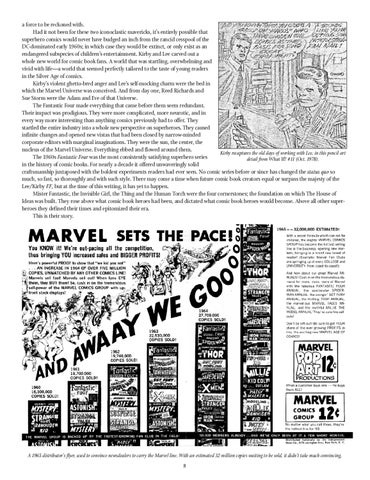a force to be reckoned with. Had it not been for these two iconoclastic mavericks, it’s entirely possible that superhero comics would never have budged an inch from the rancid cesspool of the DC-dominated early 1960s; in which case they would be extinct, or only exist as an endangered subspecies of children’s entertainment. Kirby and Lee carved out a whole new world for comic book fans. A world that was startling, overwhelming and vivid with life—a world that seemed perfectly tailored to the taste of young readers in the Silver Age of comics. Kirby’s violent ghetto-bred anger and Lee’s self-mocking charm were the bed in which the Marvel Universe was conceived. And from day one, Reed Richards and Sue Storm were the Adam and Eve of that Universe. The Fantastic Four made everything that came before them seem redundant. Their impact was prodigious. They were more complicated, more neurotic, and in every way more interesting than anything comics previously had to offer. They startled the entire industry into a whole new perspective on superheroes. They caused infinite changes and opened new vistas that had been closed by narrow-minded corporate editors with marginal imaginations. They were the sun, the center, the nucleus of the Marvel Universe. Everything ebbed and flowed around them. Kirby recaptures the old days of working with Lee, in this pencil art The 1960s Fantastic Four was the most consistently satisfying superhero series detail from What If? #11 (Oct. 1978). in the history of comic books. For nearly a decade it offered unwaveringly solid craftsmanship juxtaposed with the boldest experiments readers had ever seen. No comic series before or since has changed the status quo so much, so fast, so thoroughly and with such style. There may come a time when future comic book creators equal or surpass the majesty of the Lee/Kirby FF, but at the time of this writing, it has yet to happen. Mister Fantastic, the Invisible Girl, the Thing and the Human Torch were the four cornerstones; the foundation on which The House of Ideas was built. They rose above what comic book heroes had been, and dictated what comic book heroes would become. Above all other superheroes they defined their times and epitomized their era. This is their story.
A 1965 distributor’s flyer, used to convince newsdealers to carry the Marvel line. With an estimated 32 million copies waiting to be sold, it didn’t take much convincing. 8
